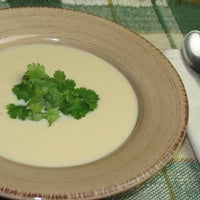Guest Chef William Bloxsom-Carter

The chef’s unique Parsnip-Apple Bisque is made entirely of fresh ingredients and works equally well as a perfect mid-day meal that will take the chill out of a cold afternoon, or an elegant first course in a more formal dinner setting.
As with the preparation of all bisque recipes, Chef William layers each ingredient in a specific sequence that starts with a sauté of the main components, but gradually evolves into a creamy purée. The chef’s choice of a few key vegetables and a seasonal fruit to play supporting roles to the primary ingredient, often referred to as the lowly parsnip, raises this ordinary root to a dizzying height in flavor experience that clearly demonstrates what separates the culinary professional from the rest of us home cooks.
Chef Carter’s recipe, as a cooking exercise, also provides a great opportunity to savor the stages of preparation that distinguishes bisque from soup. The word “bisque” refers to the fact that a soup is cooked twice, so to speak. That is, the traditional bisque usually begins by sautéing the primary ingredients in a heavy-bottomed pot. Next, a dense broth is made by adding wine, soup stock and spices to the sautéed ingredients under a low flame. After adding cream, the entire mixture is puréed, strained and slow-simmered until it thickens.
Bisque is a close relative of chowder, another creamy soup. The difference being that chowders have thick chunks of ingredients in a rich creamy base, while bisque has a uniform creamy texture. Interestingly, the two soups have also symbolized the cuisine of the upper and lower classes since the Renaissance. That is, a bisque was usually served at white tablecloth events because of its even texture, complex flavor and vibrant color. Chowder, on the other hand, was considered more of an everyday dish of the common man and never served at formal dinners. Of course, these historic culinary stereotypes remain to a much lesser degree in modern day restaurants; though you would be hard-pressed to find bisque of any kind offered on many urban neighborhood café menus in this country!
While parsnips are available year-round, the winter harvests of this root are the most flavorful, once the crop has been exposed to frost. Parsnips are very high in starch; cold temperature triggers the conversion of that starch into sugar. In fact, due to their natural sweetness and nutty flavor, parsnips were considered a dessert ingredient, to be served with honey or in fruitcakes, in ancient Rome. Chef Carter takes full advantage of this root’s sweet heartiness to create wonderfully rich bisque, fit for an emperor’s feast...or as a hot lunch in January!
The recipe itself is simple, straight forward and fun to do right – that is, in the proper progression. The phrase ‘layering of flavors’ is an over-used culinary description that, frankly, this writer tries to avoid. That said, the process is really the secret to making good bisque. The distinct characteristics of each component are absorbed separately, each adding yet another aspect of flavor to the sum of the whole.
A few helpful hints were discovered during the preparation of this dish that should be shared, though they are definitely at the writer’s own expense. Firstly, beware of using too much lemon grass. It looks innocent enough but is packed with lemony flavor, so use as directed. Admittedly, I found this out by adding a few extra crushed stalks thinking that my lemon grass pieces were a little undersized.
Also, compounding the lemon grass, in that first prep I assumed that Chef Carter had accidentally omitted the word “peeled” regarding the Granny Smith apples. So I peeled first and asked questions later, only to be told that the apples were not peeled for fear of the fruit turning brown while waiting to be added to the pot. I had eliminated this potential discoloration in my prep by staging the apple pieces in lemon water. Lesson: since the skin will be strained out anyway, the lemon water soaked apples were unnecessary and no doubt a factor in super-sizing the citrus influence in my first preparation. Hmmm, perhaps an innocent lemon grass stalk has been wrongly convicted!
I prepared the dish a second time, following the chef’s recipe exactly. The taste was much better balanced and a smooth texture was easily achieved despite those unpeeled apples. And to think all I had to do was follow Chef Carter’s recipe! (Pause here for the culinary “duh?” that I deserve!)
When shopping for parsnips use the same criteria as for carrots. Select only firm parsnips; limp and wobbly parsnips are not fresh. The root harvests in varying sizes, avoid those that are extremely large as they can have a woody core. Raw parsnips will store well in the refrigerator for up to three weeks, preferably in a perforated plastic bag. After cooking, they will only keep for another day or two. I guess that would go for any leftovers of Chef William’s tasty bisque too, but the chances of there being anything but an empty pot is very slim!
Parsnip-Apple Bisque
Yield: 18 - 6 ounce Servings

Ingredients:
2 tablespoons Vegetable Oil
1 medium Perfect Sweet Onion – peeled, trimmed and chopped coarsely
2 cloves organic Garlic – peeled and lightly crushed
6 sprigs Fresh Thyme
2” Fresh Ginger – peeled and chopped
½ cup White Wine
2½ lbs. Fresh Parsnips – peeled, trimmed and cut 1“
2 organic Granny Smith Apples – cored and chopped coarsely
1 large Fennel Bulb – trimmed and chopped coarsely
8 cups Vegetable or Chicken stock
1½ cups Heavy Cream
2 Lemongrass stalks – 6” long, crushed
¼ bunch Cilantro - washed, Stemmed and Chopped
Salt and Ground White Pepper to taste
Preparation:
Temper a heavy-bottomed pot over medium heat. Add the vegetable oil and onion. Brown the onion stirring occasionally and then add the garlic and thyme. Stir frequently to prevent the garlic from burning. When garlic is softened, increase the flame to high and add the ginger and white wine and reduce the liquid by half. Add the parsnips, apples and fennel bulb, reduce the heat to low and cooked covered for 6-8 minutes, stirring occasionally. Add the vegetable (or chicken) stock, increase the heat to medium, stirring to incorporate and cook covered for 15 minutes. Add the cream and lemongrass, and cook uncovered for 5 minutes.
Remove the lemongrass stalks and purée using a hand immersion blender or in small batches in a counter blender taking care to avoid steam burns. Strain the bisque through a medium density china cap (or strainer) and return to a simmer over medium heat. Season the bisque to taste with salt and ground white pepper. Serve in soup bowls and garnish with chopped cilantro.
©2010 William S. Carter All rights reserved.


Leave a comment